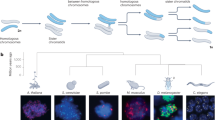Abstract
Hundreds of proteins function in cell nuclei during meiosis in plants, fungi and animals, a quarter of them being meiosis specific. Enzymes of DNA recombination are considered the most conserved; in contrast, structural proteins of meiotic chromosomes often have no orthologs outside their taxa. This especially concerns proteins that form synaptonemal complexes (SCs). Estimations of the similarity or phylogenetic relations between proteins of the same function in different organisms differ between researchers. We aimed to apply a simple quantitative method of stepwise and pairwise comparisons of amino acid sequences to evaluate the degree of similarity within groups of meiosis-specific proteins in different phylogenetic lineages of eukaryotes. We established that the recombination proteins RAD51, DMC1 and MLH1 are more conserved than the structural proteins of meiotic chromosomes. However, their functional domains are only slightly more conserved than the whole molecules in RAD51, DMC1 and MLH1 or are not conserved at all in meiotic endonuclease SPO11. In general, the proteins that provide for precise DNA strand exchange (RAD51 and DMC1) are more conserved than other recombination proteins (MLH1 and SPO11). Concerning variable structural proteins of meiotic chromosomes, cohesins and some SC proteins, we found the similarity of their functional domains to be two to five times higher than that of the whole molecules, which probably reflects the function of these domains to bind DNA. Our data are consistent with the suggestion that there is high selection pressure on the sequence of DNA strand exchange proteins RAD51 and DMC1 and less selective pressure on resolvase MLH1. A more detailed investigation of variability in SPO11 endonuclease is needed.





Similar content being viewed by others
References
Bogdanov YF, Dadashev SY, Grishaeva TM. Comparative genomics and proteomics of Drosophila, Brenner’s nematode, and Arabidopsis: identification of functionally similar genes and proteins of meiotic chromosome synapsis. Russ J Genet. 2002;38:908–17.
Grishaeva TM, Dadashev SY, Bogdanov YF. Meiotic Rec8 cohesins and their mitotic Rad21 orthologs: comparison in silico. Mol Biol (Moscow). 2007;41:674–6.
Heidmann D, Horn S, Heidmann S, et al. The Drosophila meiotic kleisin C(2)M functions before the meiotic divisions. Chromosoma. 2004;113:177–87.
Heyting C. Synaptonemal complex: structure and function. Curr Opin Cell Biol. 1996;8:389–96.
Hunter N, Kleckner N. The single-end invasion: an asymmetric intermediate at the double-strand break to double-holliday junction transition of meiotic recombination. Cell. 2001;106:59–70.
Keeney S. Spo11 and the formation of DNA doublestrand breaks in meiosis. Genome Dyn Stab. 2008;2:81–123.
Kitajima TS, Kawashima SA, Watanabe Y. The conserved kinetochore protein shugoshin protects centromeric cohesion during meiosis. Nature. 2004;427:510–7.
Kumar R, Bourbon H-M, de Massy B. Functional conservation of Mei4 for meiotic DNA double strand break formation from yeasts to mice. Genes Dev. 2010;24:1266–80.
Loidl J. Conservation and variability of meiosis across the Eukaryotes. Ann. Rev. Genet. 2016. https://doi.org/10.1146/annurev-genet-120215-035100
Marcon E, Moens PB. The evolution of meiosis: recruitment and modification of somatic DNA-repair proteins. BioEssays. 2005;27:795–808.
Muniyappa K, Kshirsagar R, Ghodke I. The HORMA domain: an evolutionarily conserved domain discovered in chromatin-associated proteins, has unanticipated diverse functions. Gene. 2014;545:194–7.
Page SL, Hawley RS. The genetics and molecular biology of the synaptonemal complex. Annu Rev Cell Dev Biol. 2004;20:525–58.
Pasierbek P, Jantsch M, Melcher M, Schleiffer A, Schweizer D, Loidl J. A Caenorhabditis elegans cohesion protein with functions in meiotic chromosome pairing and disjunction. Genes Dev. 2001;15:1349–60.
Penkina MV, Karpova OI, Bogdanov YF. Synaptonemal complex proteins: specific proteins of meiotic chromosomes. Mol Biol (Moscow). 2002;36:304–13.
Priming M, Williams RM, Winzeler EA, Tevzadze GG, Conway AR, Hwang SY, Davis RW, Esposito RE. The core meiotic transcriptome of budding yeast. Nat Genet. 2000;26:415–23.
Revenkova E, Jessberger R. Keeping sister chromatids together: cohesins in meiosis. Reproduction. 2005;130:783–90.
Shinohara A, Shinohara M. Roles of RecA homologues Rad51 and Dmc1 during meiotic recombination. Cytogen Genome Res. 2004;107:201–7.
Smith AV, Roeder GS. Cloning and characterization of the Kluyveromyces lactis homologs of the Saccharomyces cerevisiae RED1 and HOP1 genes. Chromosoma. 2000;109:50–61.
Stassen NY, Logsdon JM Jr, Vora GJ, Offenberg HH, Palmer JD, Zolan ME. Isolation and characterization of rad51 orthologs from Coprinus cinereus and Lycopersicon esculentum, and phylogenetic analysis of eukaryotic recA homologs. Curr Genet. 1997;31:144–57.
Waldman Ben-Asher H, Shahar I, Yitzchak A, Mehr R, Don J. Expression and chromosomal organization of mouse meiotic genes. Mol Reprod Dev. 2010;77:241–8.
Zickler D, Kleckner N. Meiotic chromosomes: integrating structure and function. Annu Rev Genet. 1999;33:603–704.
Funding
This work was supported by Russian Foundation for Basic Research [Projects No 16-04-01447 a and No 17-00-00429 COIFI] and the State Assignment [Contract No 0112-2016-0008] with the use of the equipment of the SC “Genetic polymorphism” of Department of Biological Sciences RAS.
Author information
Authors and Affiliations
Corresponding author
Additional information
This article is dedicated to the memory of Profs. AK Sharma and Archana Sharma.
Electronic supplementary material
Below is the link to the electronic supplementary material.
Rights and permissions
About this article
Cite this article
Grishaeva, T.M., Bogdanov, Y.F. Conservation of meiosis-specific nuclear proteins in eukaryotes: a comparative approach. Nucleus 61, 175–182 (2018). https://doi.org/10.1007/s13237-018-0253-8
Received:
Accepted:
Published:
Issue Date:
DOI: https://doi.org/10.1007/s13237-018-0253-8




